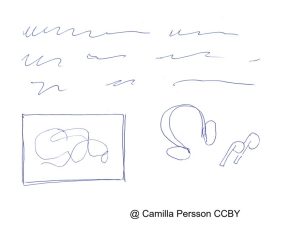Now it’s time for me to reflect on my participation in the ONL252 course. It’s a course based on networking and I think that is the strength of the course.
- What are the most important things you have learned through your engagement in the ONL course? Why?
- It’s good to be able to listen!
- Activate students
- Think of licenses, there are different cc-licenses.
- Examples of available tools to work in: for example Canva, Miro, Gemini, Padlet
Listening is an ability – because the human relationships/interactions are so important
Student-active learning – because students need to process and do themselves to learn
CC licenses and digital tools – to be able to do something, you need a toolbox
- The ride: How did you find collaborating in an online PBL group?
Inspiring!
- Benefits: What were the benefits?
That I allocated time to reflect
To meet others, to have a group to discuss with
To get to know a little bit about how it can be in different parts of the world.
- Challenges: What were the challenges?
I think all of us that participated in the course were involved in a lot of other things, so finding time effective ways of exchanging relevant information and building team spirit I guess is a challenge in the course.
- How will your learning influence your practice?
Hard to say, I don’t have anything concrete. I have had time to reflect a little in general, and expanded my repertoire of concepts and tools a bit. Maybe something from there slips into the teaching. A new way to actively collaborate and share information.
- Takeaway: What would you like to take with you into the future?
Every insight
- What are your thoughts about using technology to enhance learning/teaching in your own context?
Technical aids can be used so that material can be shared and taken part of, not only in the moment, but at different times and in different places. They can also be used for structuring. By using technology for e.g. certain repetitive tasks, the focus can be placed on processing/discussing/developing thoughts about/creating together.
I think AI can be good at the moment for idea-inspiration and as a help to answer: How could others do/answer/illustrate this? But, I know that I have to be critical of the answer. I think it’s good to use available technology that can help.
- What are you going to do as a result of your involvement in ONL? Why?
I don’t have anything special planned that depends on this Open Network Learning course, unfortunately. Some thoughts about whether it could be possible to create some open material and thoughts that it is rewarding to exchange thoughts.
- Next steps: What are the next steps?
We will meet again in our group after the holidays. Maybe I will contribute with some open teaching material.
- What suggestions do you have (activities and/or in general) for the development of eLearning in your own teaching or context?
Though questions. I think eLearning is a very wide subject and there are a lot of things you can do. From exchanging ideas on available tools and ways to use them in good educational practice, to developing online courses and free educational materials.
- Questions: What questions do you still have?
Is educational purposes (use in eg a MOOC) seen as commercial when it comes to cc-licenses?
At first I guessed so, as they in a way may be seen as advertisement for the school that created the MOOC. But, in a way I thought it was a grey zone when the main goal is to give education to everyone.
I talked to people in my group and around me and the main opinion seem to be that it is not. – But, I recommend to use a more freely available resource if you are unsecure.
So no question remains, just now…


